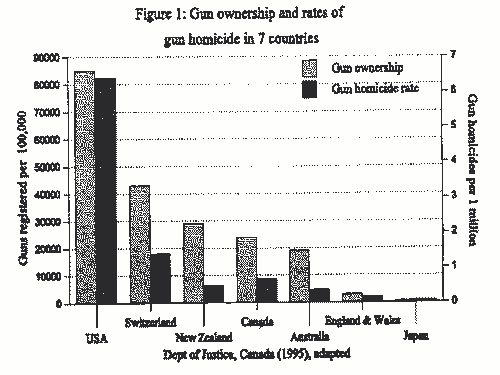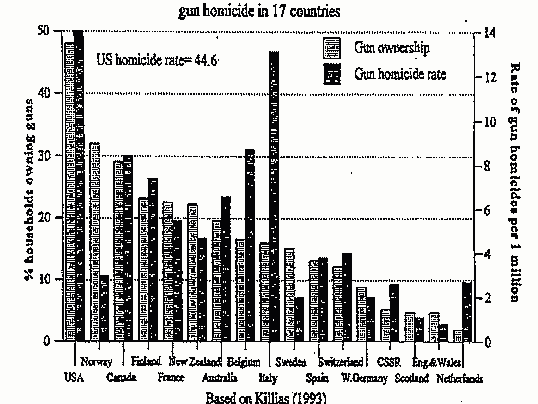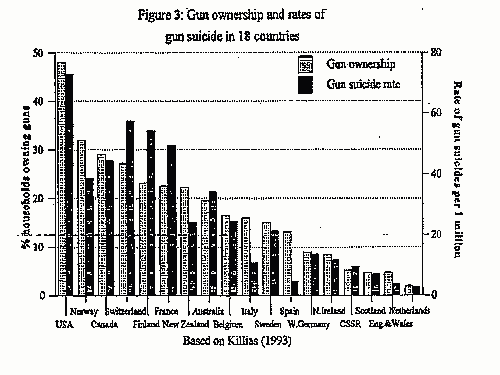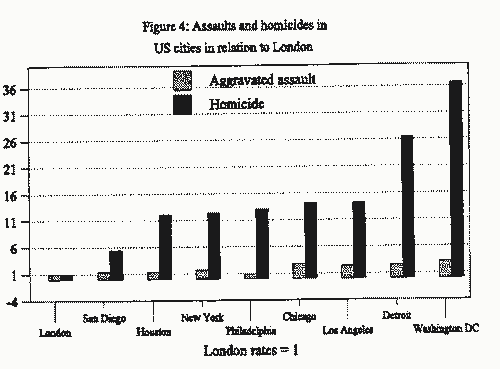This Annex considers research done to see how far gun availability is linked to the level and nature of violent crime. It starts with some points about the problem of measuring gun availability. It then sketches out some of the main arguments put forward against a gun-violence relationship as a framework in which to present some recent evidence which bears on the debate. This evidence is:
This Annex concentrates mainly on the relationship between gun availability and violent crime. It does not attempt to deal with issues about the feasibility of enforcing firearm control legislation of different types, and the effectiveness of such.
Social and historical factors clearly play a part in explaining levels of homicide and other violent crime in different countries, aside from access to guns. Nonetheless, while as will be seen England and Wales have low rates of homicide (gun-related and other) and low rates of gun ownership, it is of obvious interest whether in general jurisdictions with fewer guns in circulation, and tighter controls over gun use, lower rates of violent death occur. From a criminal justice perspective, the question is most pertinent in relation to homicides and non-fatal gun assaults and robberies. Gun availability, however, also has wider public health implications because of gun suicides and accidental gun injuries. Recently, indeed, the 'gun control' debate has increasingly taken suicide into account, at least on the academic front. This is understandable given that in most countries there are considerably more gun suicides than gun homicides.[1]
The case can be made that research has had relatively little influence on the political debate about gun control in North America. One reason for this is that academic debate itself has often been ideologically cast, with some of the literature partisan - and thus more easily discounted. More important is that establishing for certain whether easy access to guns is related to violent crime is far from easy. That said, there are firm political and academic proponents of two opposing positions:
A major difficulty has been the lack of a satisfactory measure of gun availability, especially as this should encompass both the number of guns in circulation, and their accessibility to those with criminal intent. Some US studies have used firearm production and import figures (which discount exports, and how far new guns simply replace old weapons). Others have used numbers of legally held firearms (measured through permits issued), which leave untapped existing firearms illegally acquired. Yet other studies have employed sample survey data on gun ownership, nearly all counting the proportion of households with guns rather than the number of guns owned. In the US, there are measures of national and regional gun ownership across time, but no survey information on levels of ownership in the individual states. Recently, a measure of household gun ownership in a number of different countries has become available from the International Crime (Victimisation) Survey, which is discussed below.[2]
Other researchers have taken instead indirect indicators of gun availability. These have principally been the accidental death rate from firearms, the percentage of homicides committed with a gun, the percentage of suicides committed with a gun, or a combined measure of both homicide and suicides committed with a gun. The recent conclusion of one expert is that the percentage of suicides using firearms is is a valid proxy of gun ownership, but not the percentage of homicides using guns, even though this has formed the basis of many evaluative studies (Killias, 1993).
Much research has been in relation to the US. It has either compared gun availability in individual states or regions in terms of violent deaths at a particular point in time, or looked at whether changes in gun availability as a result of enforcement me asures are linked to changes in violent crime rates. Until recently, comparisons of gun availability and violent deaths in different countries have been few. It is not surprising, given the importance of the gun-violence issue, that there have been several overviews of research. Some of the most important of these are: Cook, 1991; 1983; Killias, 1993; Kleck, 1991; Wright et al., 1983; and Zimring and Hawkins, 1987. Details are in the bibliography.
In America principally, those who contest an association between gun availability and levels of homicide (or who at least promote the value of a highly armed population), generally depend on two main arguments. The first is that "guns don't kill people, people kill people". The second is that research has not effectively proved the association between wider gun availability and higher homicide rates, especially given that
These arguments seem pertinent to all countries. A further one - that ownership of guns for selfdefence is an effective way of deterring both violent and property crime - is more relevant to countries in which the choice to own a gun as a defensive weapon is seen as a reasonable civic right; this is not dealt with here.
A major argument put forward against firearm controls is that those intent on killing who are deprived of a gun would simply turn instead to another weapon - a 'displacement effect'. This proposition has generated a extensive research literature, the results of which have been read in different ways. Certainly, a resourceful offender will find a way to kill if determined enough (and knives are much easier to come by everywhere). However, the likelihood of weapon substitution (or the use of sufficient brute force) in every potential violent incident seems implausible. One reason for this is the 'advantage' of guns themselves, providing for instance
There is one element in the weapon substitution debate on which there is consensus. This is that incidents in which guns are involved are much more likely to end in death or more serious injury than incidents involving other weapons such as knives, broken glass or fists. The most conservative American estimate is that firearm attacks are twice as likely to result in death as knife attacks (Reiss and Roth, 1993), although other assessments usually put the differential much higher than this. Thereafter, consensus breaks on how this pattern is to be interpreted - the essential issue being what offenders intend to achieve. Those arguing that offenders would choose a course of action or weapon to achieve the same effect as a gun believe that the choice of a gun signifies lethal intent. The con position, briefly, is that many violent incidents are not the result of a deliberate intent to kill, and that those which end in death are in origin and circumstance rather similar to a larger set of assaults and robberies in which the victim does not die. Studies of robbery tend to indicate that many incidents are committed fairly spontaneously, rather than in a premeditated manner. The same will be true of many assaults, especially those in domestic settings, or those following bouts of drinking. The weapon to hand, then, will be important in detemiining the outcome. In spontaneous violent incidents, offenders for whom guns are unavailable may well use something else, but the outcome is highly likely to be different. In this regard, though, there is an important difference established between robbery and other offences. There is considerable consensus that robbers armed with guns are less likely to attack and injure since, faced by a gun, their victims are more compliant.
The second challenge to the association between gun availability and levels of homicide rests on the firmness of the evidence. Cross-sectional analyses and evaluations over time of specific gun control measures in certain states in the USA or (more occasionally) different countries are seen as not providing strong enough support to link gun availability with homicide levels categorically (see, notably, Kleck, 1991). This conclusion has been challenged in turn again, however, by reference to some of the research on which it is based - principally that:
A related argument from those resistant to seeing wider gun availability linked to higher homicide rates is that any evident association between the two derives from merely correlational studies, which do not prove any causal relationship. Thus, a 'gun culture' could also be an exceptionally violent culture. In tandem with this is the possibility that increases in criminality itself could create greater demand for firearms - although as Killias (1993) persuasively argues, suicide rates vary internationally with gun availability in the same way as homicide, and few would argue that high or increasing suicide rates prompt more people to purchase guns.
The Canadian Department of Justice have recently collated information from relevant agencies in eight countries on levels of legally held guns and rates of homicide and suicide.[3] France was one of the countries included but the information provided is problematic in various respects.[4] Figure 1 below shows results, excluding France. The number of countries included is relatively small, but on the face of it there is a fairly suggestive relationship between gun ownership and gun-related homicides. Table A.1 at the end of the paper shows further details of the relationship with other fatality measures.[5]

Martin Killias of the University of Lausanne has harnessed results on household gun ownership from the first (1989) and second (1992) IC(V)S to look at the relationship with levels of homicide and suicide in a larger number of different countries (Killias, 1993).[6] No account is taken of the number of guns held, and the measure of gun ownership is subject to sampling error, although for the six countries in both surveys the gun ownership level from each was very similar, and the IC(V)S figure for the US is also very similar to those from other US surveys. To improve reliability Killias averaged homicide and suicide figures mainly for the years 1983 to 1986 - so the gun and fatality measures do not relate to exactly the same period.
Figure 2 shows Killias's results with respect to gun ownership and gun-related homicide rate. Detailed figures are in Table A.2 at the end of the paper. (The Swiss gun ownership rate excluded military guns, and Northern Ireland has been excluded because of its unusual homicide situation.) It is clear that the relationship between gun ownership and homicide is not exact. Italy and Belgium in particular have more gun homicides than would be predicted if gun availability was seen as the main determinant of gun-related homicide levels, whereas Norway and Sweden have less. Nonetheless, the overall picture indicates a strong statistical association between gun ownership and gun-related homicide.[7]

Figure 3 shows the relationship between gun ownership and gun-related suicide - a rather neater picture than for homicide.[8]

A central issue in relation to these results bears on the 'displacement effect': whether guns are used merely as a substitute for knives and other potentially lethal methods of killing. If this is so, one would expect higher rates of gun homicides and suicides to go along with lower rates of other forms of death. Killias results do not support this, particularly in relation to homicide. Rather, countries with high gun ownership and higher rates of gun-related deaths, tend to have as many non gun-related deaths. The implication he draws from this is that guns increase death rates beyond a country's natural propensity to killing.
This is a controversial point. The main challenge has been that some other factor - such as a 'violent culture' might explain high gun ownership, high gun killings and, high forms of other death. This is very hard to test, though one well-known study bears upon it. This is that of Sloan and his collegues who looked at Seattle (in Washington state) and Vancouver (in Canada) on the grounds that they differed with respect to gun availability, but were very alike in terms of geography, climate, history, demographic and socioeconomic factors - all of which might arguably produce similar cultures of violence (Sloan et al, 1988). The two cities were shown to have similar rates of assault, although more of Seattle's assaults were committed with a gun. The homicide rate in Seattle was about two-thirds higher than in Vancouver, all the difference being in the rate of gun homicide. The Seattle/Vancouver study has not escaped criticism, but it remains an often-quoted piece of evidence by those in favour of gun control.[9]
A comparison of more domestic interest regarding whether high levels of homicide in the US reflect a 'violent culture' more than a 'gun effect' was made by Clarke and Mayhew (1988). Their purpose was to compare gun and non-gun homicide levels in the two countries to see how they differed. Table 1 updates their figures, though it shows a very similar picture to the comparison based on an earlier period. Thus, gun-related homicides overall are 50 times higher in the US than in England and Wales, and handgun figures 150 times higher; non-gun homicides are merely three times higher in the US.
Average annual rate
per lm
England E&W/USA
& Wales USA ratio
All gun 1.02 51.92 1:51
Handgun 0.26 38.97 1:150
Other gun 0.77 12.95 1:17
Non-gun 10.28 33.56 1:3
Total 11.30 85.48 1:8
A similar picture emerges in relation to serious violence. Rates of aggravated assault in the US are about 25% higher nationally than in England and Wales, in contrast to a sevenfold to eightfold difference in overall homicide rates. Moreover, the difference holds up at city level - a comparison worth making since it might be argued that the national picture regarding assaults conceals a much worse situation in American cities. Figure 4 contrasts 1993 rates of serious assaults and homicides in London - for which rates are indexed at 1 - with eight of the largest US cities (information is not available to differentiate gun-related and non gun-related incidents). Assault rates in the US cities were about half to three times higher than in London. Homicide rates, however, were between about five and twenty-five times higher in the US cities.

Gun ownership |Homicide |Gun homicide| Suicide |Gun suicide rate per 100k |rate per lm|rate per lm |rate per 1m|rate per lm USA 85,000 9.3 6.40 12.0 7.1 Switzerland 43,000 1.5 1.40 20.4 5.8 New Zealand 29,000 2.6 0.49 14.5 2.5 Canada 24,000 2.2 0.67 12.8 3.0 Australia 19,000 1.8 0.36 11.6 2.5 Britain 3,000 1.3 0.14 8.6 0.4 Japan 400 1.2 0.06 19.3 0.14 [France [23,000] 4.9 2.32 20.0 4.9]
Rate per million
Homicide Suicide % households
Overall With gun Overall With gun with guns
USA 75.9 44.6 124.0 72.8 48.0
Norway 12.1 3.6 142.7 38.7 32.0
Canada 26.0 8.4 139.4 44.4 29.1
Switzerland 11.7 4.6 244.5 57.4 27.2
Finland 29.6 7.4 253.5 54.3 23.2
France 12.5 5.5 223.0 49.3 22.6
New Zealand 20.2 4.7 137.7 24.1 22.3
Australia 19.5 6.6 115.8 43.2 19.4
Belgium 18.5 8.7 231.5 24.5 16.6
Italy 17.4 13.1 78.1 10.9 16.0
Sweden 13.3 2.0 182.4 21.2 15.1
Spain 13.7 3.8 64.5 4.5 13.1
W.Germany 12.1 2.0 203.7 13.8 8.9
N. Ireland 43.3 21.3 82.7 11.8 8.4
CSSR 13.5 2.6 117.8 9.5 5.2
Scotland 16.3 1.1 105.1 6.9 4.7
Eng & Wales 6.7 0.8 86.1 3.8 4.7
Netherlands 11.8 2.7 117.2 2.8 1.9
This document available in PDF version